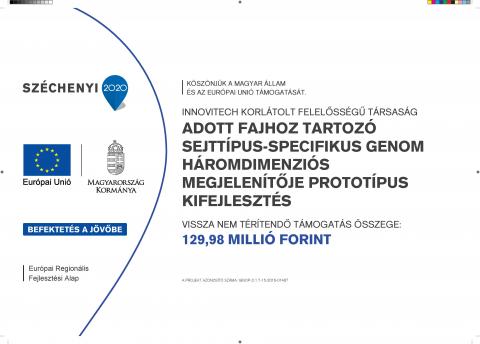

Why R&D is important to us?
Since several members of our leadership team are currently active researchers with doctoral scientific degrees, the search for innovative solutions is naturally of utmost importance to us.
Our establishment was motivated by the need to bridge the gap between the competitive IT sector and the scientific community. By facilitating collaborations between higher education institutions and companies through concrete research and development projects, we aim to provide effective support so that the Hungarian IT industry can enter the international market with competitive and novel solutions.
Development of a functional genomic and imaging diagnostic framework to support early oncology diagnostics and therapy selection
The goal of the project is to develop an artificial intelligence-based IT decision support system for the field of oncology, built on a bioinformatics and imaging diagnostics foundation. This system aims to assist in early diagnostics and the development of personalized therapies.
The development has significant innovative value, as it includes the analysis of functional genomic correlations using machine learning methods, enabling the detection of previously unknown genomic markers critical for early diagnostics and therapeutic efficacy. Beyond examining the coding regions of the genome, additional genomic pattern details will also be analyzed, addressing a critical gap in current diagnostic and therapeutic services.
Another key innovation target of the project is the automation of tumor segmentation in PET/CT radiological image processing using deep learning methods, which is expected to enhance the early detection of tumor tissues.
The project’s innovation spectrum is further broadened by objectives related to spatial simulation of genomes, enabling the comparison of spatial structural profiles of genomes derived from different cellular states. The resulting technology will facilitate the analysis of spatial genomic structural distortions in relation to functional genomics, mutations, and clinical data.
The disease type studied during the project is diffuse large B-cell lymphoma. A highlighted goal is to ensure flexible biomarker discovery for diagnostic and therapeutic decision support for other disease types as well.
The InnovITech is participating in the development as a leader, other consortium members: GE HealthCare, Széchenyi István University, clinical partners: University of Debrecen, Petz Aladár University Teaching Hospital.
Project ID: 2023-1.1.1-PIACI_FÓKUSZ-2024-00027
Contracted amount of subsidy: HUF 791 377 269
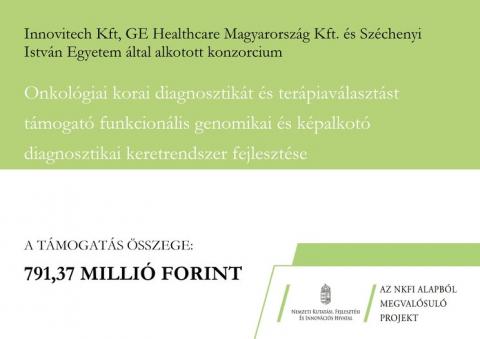
“Information management and information trading are the services of the future” – The research and development project of InnovITech Ltd. entitled “Implementation of secured health personal data management and providing value-based information trade in healthcare” has been accomplished.
The IBB – InfoBank&InfoBroker system implemented by our company provides a completely new approach for information management services. Based on the clarification of digital ownership, it offers a solution for the management of the data treasure to be stored (InfoBank) and the implementation of information value trading from the data treasury (InfoBroker).
The amount of data treasure is rapidly growing worldwide and therefore, managing the ownership of digital data and description of data can be interpreted as an important opportunity. InfoBank service provides the storage and ownership management of data resources around the world. We need to realize that information represents a real value, even convertible to money, which, based on its correct handling, can be an advantage for the owner of the digital data treasure and the requester of digital data resource information. The protection of personal information can be ensured by validation procedures in compliance with the Personal Data Protection Act.
Value-based information trading can be interpreted as an emerging priority service (InfoBroker) on the global market. The developed mechanism for determining the information value, the management of information sales and purchase requests provides the foundation for value-based sales of information. The settlement mechanism of the procedure has been approached in an innovative way. InfoBroker conducts transactions with the information itself based on, its supply of demand priorities. Thus, the value determination of information is based on the demand needs for information and their priorities. The transaction, in the course of the sale and purchase of the data treasure, changes the digital ownership of the information, and the selling value of the information is recorded in the seller’s information value account. Services related to the implementation of value-based information sales and trades are innovative procedures that did not exist before at national or international level. The primary target area of the scheme is to ensure value-based trade in healthcare data, but it is important to stress that it is not limited to the context of the healthcare data market.
The novelty of the system’s services lies in the fact that it enables the safe storage, management and sale of value-based information and allows the upload of health-related personal data and therapeutic possibilities to the InfoBank database. Therefore, creating a health subject area of focus. The owners of healthcare data are in interdependence from an information demand point of view. This mutual dependency can be interpreted as a pair of information needs and can result in two-way value-based information sales and purchase transactions through InfoBroker services. It is essential to identify these types of needs as the mutual information need pairs are a sustainable driver of value-based information trades. According to the identified information request, therapeutic data and personal health data exchange owners, according to which the healthcare provider possessing the therapeutic data can obtain specific personal health data by transferring appropriate therapeutic data to the original owners of the personal data.
The service spectrum of the system is extended by the possibility of providing protected health personal data, which allows healthcare providers to access personal health data stored in InfoBank if, the owners of personal information give their consent to access it. The justification of the solution is confirmed by the fact that the current Hungarian regulations – CXII of 2011.The Law on the Right to Self-Determination of Information and Freedom of Information also classifies health data in the category of “special data”. Thus, the GDPR (EU protection of personal data management; Provision 20216/679 of parliament and of the Council (EU)) provides a novel approach to ensuring compliance, which can significantly reduce the IT costs of healthcare providers in relation to personal data processing and ensure compliance centrally by reducing the risk of personal data breaches. With this procedure, we provide the possibility for healthcare providers to access sensitive data in relation to personal data and the processing of personal data currently under restrictions, without having to deal with their strict storage and management conventions according to the regulations.
Name of beneficiary: InnovITech Ltd.
Title of the project: Implementation of value-based information exchange services that enable the access of secure health personal data processing in healthcare.
Amount of contracted subsidy: HUF 128,430,500
Subsidy rate(%) : 55%
Project scheduled completion date: 31/08/2021
Project ID number: GINOP-2.1.2-8-1-4-16-2017-00176
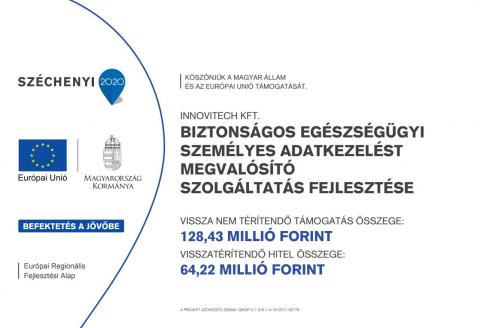
Development of microbiome analysis-based service for the study of neuro-psychiatric diseases.
The project is carried out with the professional participation of UD-GenoMed Kft. (spin-off company of the Institute of Biochemistry and Molecular Biology of the University of Debrecen) and the Psychiatric and Psychotherapy Clinic of Semmelweis University.
During the project, our goal is to implement an IT system which can perform the automated analysis of the composition of the intestinal flora and the connections between various psychological diseases. In this examination, the system should be able to record clinical data related to the studied patient, follow through full microbiome analyses and explore the links between clinical and next-generation sequencing data.
An important function of the system is the development of an expert system module based on BigData procedures for analyzing the relationships between microbiome and clinical data. By analyzing the identified correlations, we can get closer to understanding the complex interactions between intestinal flora and psychological diseases, as well as develop prognosis procedures to increase the effectiveness of medical treatment.
In addition, the application should be able to perform taxon annotation of groups of bacteria identified as a result, of comparisons and screenings (Strain, Class, Order, etc.) based, on existing metagenom databases.
By involving patients diagnosed with major depression in the research – as part of a scientific sub-project – it is possible, to test the planned service and IT system, and on the other hand, to identify the microbiome patterns responsible for the development of the two diseases and/or differences in therapeutic responsiveness. Thus, by analyzing microbiome data, disease-specific and overlapping markers can be identified with the involvement of healthy, control patients. With the implementation of the sub-project, the large database ensures the examination of the symptoms of the two diseases and the relationship between microbiome patterns by, using data mining and machine learning procedures.
The system can be characterized by the following main cases of use :
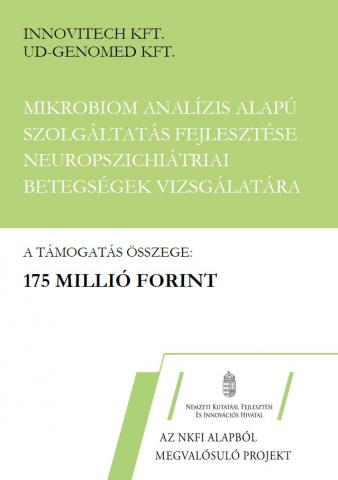
Creating a precision incision robot and a smart agricultural platform based on, image processing and machine learning processes.
The project is implemented in the form of a consortium, InnovITech Ltd., is responsible for the development of software solutions, relying on the viticultural expertise of the University of Pécs. The robotics expertise is provided by the Zoltán Bay Research Institute Nonprofit Ltd., which is complemented by the competence of SBS Ldt., in the development of vehicle technology platform.
The aim of the development is to create a self-propelled robot which can carry out complex robotic tasks on the vineyards by, processing and analyzing detected camera images of surrounding environment. This automated robotic technology replaces the high human resource capacity required to carry out the task of precision grape pruning.
As a result, we have created an autonomous viticulture, pruning vector robotics solution which can determine and execute automated pruning on vine fields, possessing the knowledge of experienced viticulture specialists. This automated technology can reduce the increasing shortage of expertise and labor in the field, and allowing weather-independent, optimal timing of pruning to be carried out on vineyard plants.
The robot will be able to automatically map a plantation, based on which it establishes the optimal pruning protocols and different options of transformation of the grape capital. Also, it is capable of monitoring and analyzing the grape crops to identify the balance of production, yield and quality.
Robotic movement and automation of pruning is backed by machine learning techniques that allow to detect and consider new expert decision-making procedures. The observed correlations in relation to the methods of pruning and decisions used, may lead to the discovery of new research results related to the development of viticulture methods and forming the basis of prospective viticulture research.
The subsequent evaluation of the decision automation related to pruning is backed by the capability of the system to examine the effectiveness per capital and to evaluate the applied pruning techniques, by continuously monitoring the plantations and examining the data collected based on big data procedures. Therefore, the robot provides an opportunity to transition to precision farming.
In addition to the above, the special advantage and wide social utility of the robotic solution and system is, that it can support the training of viticulture by modeling individual pruning decision situations with the simulation module of vine capitals. Therefore, contributing to the further refinement of the self-learning mechanism related to pruning vectors. The originated knowledge material can be connected to a training system. During the viticulture training, this capability of the developed system can provide an extremely useful support, which can also be interpreted as a marketing advantage. Finally, it also supports the continuous development of the decision bases.
Project ID: 2020-1.1.2-PIAC-RDI-2020-00097
Amount of subsidy: HUF 618,130,379
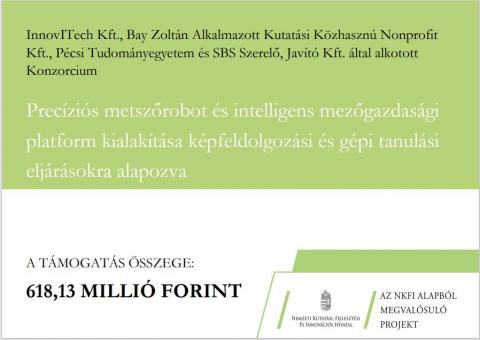
Creating an automated quality assurance service with refactoring solutions
Methods related to quality assurance of IT systems are gaining increasing importance and attention, not only in the IT industry, but also in other segments of the economy. This can be explained by the unstable IT solution on the user side, producing significant damage and creating a competitive disadvantage, due to increase in costs and the inability to respond appropriately to the market situation. Therefore, the quality assurance of IT systems is of vital importance for the national economy’s competitiveness.
With respect to source code checks, a wide range of structural properties of source code can be measured by available quality measurement tools, the so called metrics. However, the metrics for examining decision structures that significantly determine the structural quality of the program are inadequate because, decision structure anomalies are not indicated by the complexities arising from the decision structure within the components. Accordingly, the aim of the development is to create a decision structure quality meter that is a static code analysis tool suitable for doing metrics for the decision structures and applying refactoring rules (source code correction rules) related to the quality of decision structure determined, by the tool. A further aim is to support the selection of an appropriate refactoring step, to eliminate structural anomalies in quality analysis decisions with an expert system based on, machine learning procedures.
The novelty of the development is enhanced by the fact that by recognizing the decision redundancies in the decision structure, the designed system provides an opportunity to detect the application possibilities of design patterns, and decision structures can be accessed by decision combinations that can be performed by automatic refactoring procedures. Regarding the planned system, it is a novelty to provide measurement possibilities according to the metrics characterizing the overall quality of the decision structure of the examined source codes, which is supplemented by the metric-driven automatic refactoring methods (Java-based refactoring tool is not currently on the market). The novelty of the planned project is further enhanced by the fact that refactoring is driven by artificial intelligence. The need for this is justified because a structural anomaly detected by metric measurement can be corrected by a variety of refactoring steps, while other quality aspects deteriorate, so artificial intelligence is required to select the best sequence of steps. The provision and collection of teaching samples required for the teaching of artificial intelligence will be implemented as part of the project.
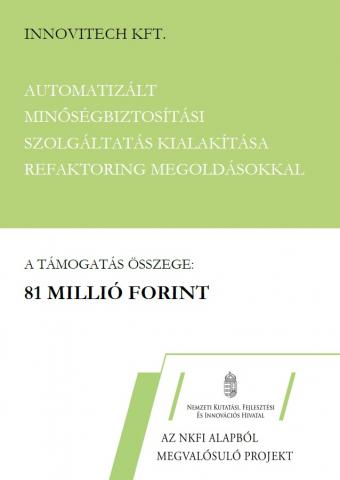
Simulation of the cell type-specific three-dimensional structure of the genome of a given species
The project was executed with the professional participation of UD-GenoMed Kft. (spin-off company of the Institute of Biochemistry and Molecular Biology of the University of Debrecen).
GenomAtlas makes it possible to predict the three-dimensional structure of the genome, based on the connection matrices obtained by processing sequencing data of a particular cell type by bioinformatic transformations.
With the help of the artificial intelligence algorithms, the visualization of the three-dimensional structure can be performed efficiently and in a user-friendly way. The application is therefore able to visualize the structure of the genome in space and perform simulations. The display is interactive, which allows users to perform various geometric transformations in a three-dimensional space with just a few clicks (zoom-out, rotate, etc.).
The developed application will also help us to get closer to understanding how different cell types, such as macrophages, can adapt to a changing environment and to examine what role the cell type-specific three-dimensional chromatin structure plays in this. The results of this research and development project provides a basis for analyzing the pathomechanisms of high blood pressure, obesity, cancer or other so-called multifactorial diseases.
The system can be characterized by the following main usecases:
The InnovITech project entitled; “ Three-dimensional display of cell type-specific genomes belonging to a given species” was supported by the Hungarian State and the European Union with a financial subsidy of HUF 129.98 million. Project ID number: GINOP-2.1.7-15-2016-01487
